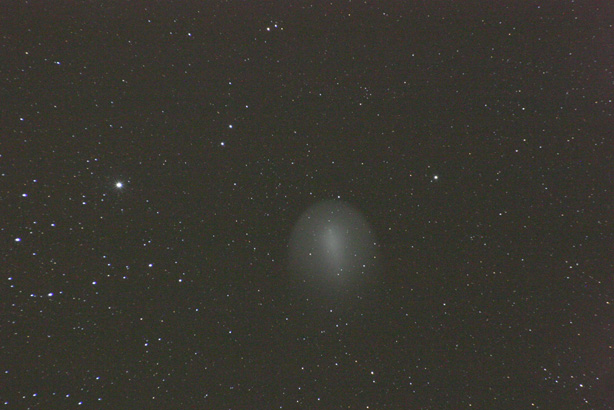Star Points for
December, 2007; by Curtis Roelle
Geminid Meteors and
a Slowly Fading Comet
Although it’s getting cold outside that’s no excuse for
staying indoors at night, especially when two interesting things are happening
the December skies above. The Geminids, maybe the best meteor shower of the
year, is coming this month. Already overhead is Comet Holmes which remains
visible during December. First, let’s talk about the what, when and where for
the Geminids.
The
Geminids is a strong shower producing an average variable rate of some 60 to
100 meteors per hour. In his
Astronomical Calendar 2007 Guy Ottewell describes the shower as “one of the
very best presently visible from Earth.”
The radiant – the meteors’ apparent point of origin in the sky – rides
high in the eastern sky at midnight and is nearly overhead two hours later.
Three circumstances favor
viewing this year’s shower on December 14-15. First, the shower occurs on a
Friday-Saturday weekend night making it easier to stay up late for it. Second, the moon sets early (9:35 p.m. EST
for Westminster) and will be long out of the way by the time the meteor shower
really gets going. Third, the Westminster Astronomical Society, Inc. (WASI)
will be hosting a public star party that evening (more about that below).
However, the best time to view
is after midnight. The closer to morning twilight the stronger the shower
should become. For Westminster, on the
morning of the 15th, astronomical twilight begins at 06:17 a.m. EST.
Temperatures are likely to get cold so it is wise to dress warmly. Your body
will not be very active and won’t be likely to be producing any excess heat so
you will need to hold what heat there is inside your many layers of clothing,
your hat, and gloves.
Comfort
is also important. Meteors are best viewed from a reclining position - A lawn
chair or portable recliner are perfect for the occasion.
I never
paid much attention to the Geminds. Then one year I was attending a WASI
sponsored public star party at Hashawha Environmental Center north of
Westminster for viewing the famed Comet Halley. It seemed like the whole town
had turned out. While people were standing in long lines for a look through the
many telescopes some began noticing the frequent appearance of bright white
meteors. Soon the Geminids were
attracting more attention than the historic comet as the crowd gasped with each
“shooting star.”
The
Geminids are debris left over from passages of an Apollo asteroid named 3200
Phaeton. In mythology Phaeton, the son of
Apollo the sun god, died suddenly when the sun-carrying chariot of his Father,
which Phaeton was attempting to steer, careened out of control. The great deserts of Africa and Asia were
instantly formed as the sun grazed and singed the earth. In a desperate effort
to save the earth and its inhabitants Zeus fired a thunderbolt into the
chariot, ejecting Phaeton who then tumbled to earth and to his death.
Astronomically,
any Apollo asteroid is one whose orbit crosses that of the earth.
Comet
Holmes has put on an outstanding show in October and November. It remains in the sky throughout December
although it is fading due to the expansion of its surrounding coma, or cloud of
dust and gas. It should remain visible in binoculars especially on clear nights
with no moon. The best place to locate
an online finder chart is someplace like the “Observing” section of
skyandtelescope.com. Binoculars are
highly recommended for finding and viewing Holmes.
A
couple of opportunities to see the comet with members of the Westminster
Astronomical Society are on Friday, December 14 at Bear Branch Nature Center
(BBNC) in Carroll County, and Saturday, December 15 at Soldiers Delight
Environmental Center in Baltimore County.
Notice that the BBNC event is on the same evening as the Geminid meteor
shower. For details see the calendar at
WestminsterAstro.org.

|
| In late October Comet Holmes (17P) brightened more than 600 thousand fold going from magnitude 17 to 2.5 in a single day. The above image taken from MTO on the evening of Tueseday, November 27 shows how the comet has diffused since the onset of the major outburst. The "false nucleus" has faded considerably as the coma continues to diffuse outward. The brightest star at the left edge of the image is Mirphak, or α (Alpha) Perseii. North is along the top edge. (The full frame image shown above is a 52 second exposure at f8 with ISO 1600 setting shot through a 300mm lens and Canon digital Rebel camera.) |